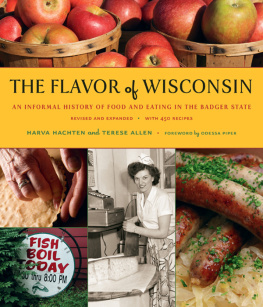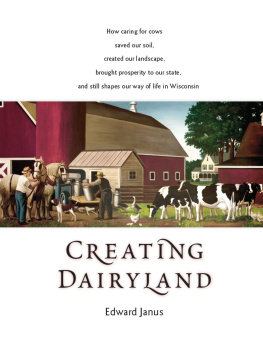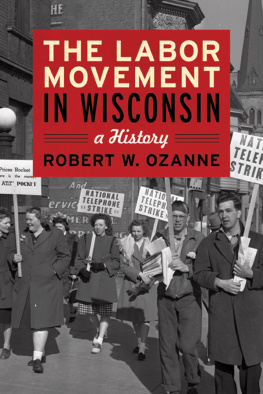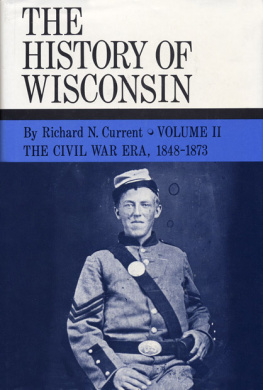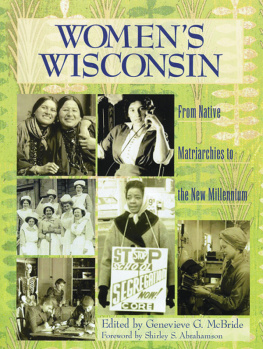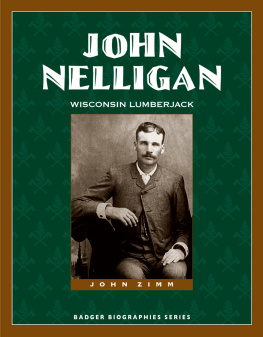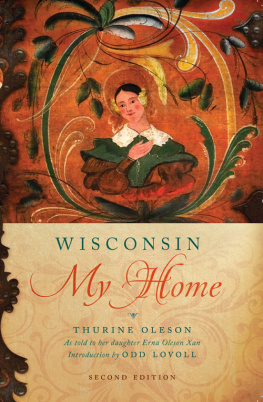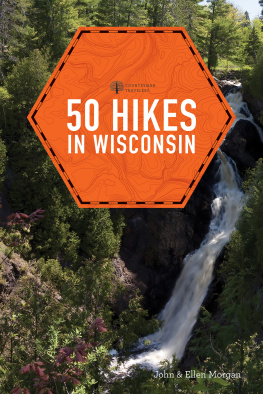ACKNOWLEDGMENTS
WHEN IT COMES TO WRITING ABOUT FOOD, as opposed to preparing it, there is no such thing as too many cooks. And certainly many people were figuratively beside me, contributing important ingredients, seasonings, relishes, and food lore to this varied spread.
First off were the more than nine hundred Wisconsinites and former state residents who contributed recipes and reminiscences. Only a fraction of their material could be included, but each and every contribution helped immeasurably to enlarge my knowledge of Wisconsins culinary past and attain a broader feeling for its flavor. I thank them all.
I am grateful, too, for the work of Rosalie Mayer of Madison, liaison with the Womens Auxiliary of the State Historical Society of Wisconsin, and the committee of home economists and food experts that she organized and supervised to screen the almost 1,600 recipes submitted. They were: Edith Bangham, Lillian Fried, Ava Jones, Joanne Kelsey, Helen F. Killingstad, Phyllis Lovrien, Marge Meier, Louella Mortenson, Iva Mortimer, Dorothy Strang, and Dorothy Traisman.
This project would have been even longer in the doing without the help and expertise of numerous members of the staff of the State Historical Society of Wisconsin who were always ready to supply encouragement, clarify a murky historical point, or chart the correct path for research. Among them were Joan Freeman, Peter Gordy, Marilyn Grant, Sara Leuchter, Mary McCann, Christine Schelshorn, Joan Severa, George Talbot, and the late Raymond S. Sivesind. I am indebted to Paul Hass, head of the Societys editorial division, whose unfailing good humor and refined diplomatic skills kept this project on track, and most especially to John O. Holzhueter, associate editor of the Wisconsin Magazine of History. I found it convenient and expedient to have Jack easily available during both the organization and the writing of this book; if he could not readily come up with a requested historical fact from his remarkable encyclopedic memory, he knew just where to find it in the written record. I am particularly appreciative of the improvements to the manuscript that resulted from his careful scrutiny of facts and figures throughout the book.
The student assistants I had at various times over the years were exceedingly important to this undertaking: researcher Elizabeth Hachten, who spent many hours one summer in the Societys archives deciphering spindly nineteenth-century handwriting, and Linda Levendusky and Mariann Goss, who tied up numerous loose ends. Most important of all was my project assistant for two years, Timothy N. Walters, now assistant editor of Horizon magazine, who organized the research, did the lions share of it, and revealed to me the efficacy of the 4 x 6 index card as a research and writing tool.
Finally, I wish to acknowledge the valuable support and assistance provided by my husband, William A. Hachten, professor of journalism in the University of WisconsinMadison. He is unexcelled as a coddler of a writers ego, as an implacable setter of deadlines, and as an exciser of cliches. I doubt even he knows how important were his insights and sure editorial sense before, during, and after I set words to paper.
H.H.
1981

EVERYONE HARVA THANKED, I THANK Plus Harva herselffor bringing an immensely valuable resource into my life.
For making it an intimate part of my life, I thank Kate Thompson and Kathy Borkowski of the Wisconsin Historical Society Press. Right after the three of us first met at a State Street coffeehouse to discuss my role in the second edition of Flavor, I went home and gently, gleefully banged my head against the kitchen wall. The project seemed immense, intimidating, and exactly what I wanted to do.
Kate Thompson, the books editor, was flat-out wonderful to work with. She has keen book sense and a sharp eye. She is professional and wise. How many writers can say they respect, enjoy, and appreciate their editor? I can.
Even with Kate as a partner, though, Id still be floundering if it werent for the assistance of Kate Carey, Liz Wegner, Courtney Byelich, and Mallory Kirby. They were the Wisconsin Historical Society interns who ransacked newspaper files, magazines, and Web sites in search of source materials, hunted down photographs and artwork, and handled myriad other tasks promptly and efficiently. (This is also the place to mention the pedaling couriers who, spring, summer, fall, and dead-of-winter, biked hard copies of research from the Society offices to my doorstep.)
Several authorities read and commented on the parts of the book that cover their areas of expertise. Im so grateful for the generosity (and little red flags) of Jerry Apps (cheese, beer), Laurie Greenberg (cheese and dairy), John Motoviloff (fish), Janet Gilmore (fish fry, booyah), and Shirley Cherkasky (fish boil). My husband, Jim Block, would not call himself an authority in this area, but because of his amazing memory for detail and his affection for all things Wisconsin, others might. He read numerous sections, caught a number of things, and, in my mind at least, re-sealed his reputation as a Dairy State savant.
Many resources informed this edition; a few books, markedly so: Cheese: The Making of a Wisconsin Tradition (1998) and Breweries of Wisconsin (1992, 2005), by Jerry Apps; The Atlas of Ethnic Diversity in Wisconsin, by Kazimierz J. Zaniewski and Carol J. Rosen (1998); Wisconsin Indians, by Nancy Oestrich Lurie (2002); and The Future of Farming and Rural Life in Wisconsin: Findings, Recommendations, Steps to a Healthy Future (2007).
The bibliography references lots of the articles, interviews, presentations, and other sources that helped me along the way (there just wasnt room or time to list them all), but Id like to acknowledge here some folks whose writing or knowledge was pointedly useful: Courtney A. Cain, John Motoviloff, Shirley Cherkasky, Janet Gilmore, Joanne Raetz Stuttgen, Ron Seely, John D. Buenker, Laurie Greenberg, Karen Herzog, David Kamp, Jerry Minnich, Robin Shepard, Yvonne R. and William G. Lockwood, David A. Taylor, Richard March, and Dennis Zeloski.
Gracias to Marc Eisen, former executive editor of Isthmus newspaper, for letting me off the column-writing hook for six months while I got my act together on this project, and to Erika Janik, for pinch-hitting for me during that leave of absence. Isthmus, too, helped make this book happen by first publishing articles of mine that have now made their adapted way into Flavor. Likewise, thanks to other mediaWisconsin Trails, Milwaukee Journal Sentinel, Wisconsin Women, and Anew (now Brava)in which Ive written columns or features that show up in some fashion between these pages.
Im grateful to several cooks who tested recipes that, largely due to changing food jargon, had caused me or Kate Thompson to go huh? when we were reviewing the recipe sections. The people who helped us solve the niggling mysteries, recruited through the Culinary History Enthusiasts of Wisconsin (CHEW), were Traci Nathans-Kelly, Paul Lyne, Linda Bunger, Ann Christensen, Stephanie LaBella-Luke, Susan Watson, Trish Iaccarino, and Sharel Nelson.
A bow, also, to production editor Elizabeth Boone, copyeditor Thomas Kozachek, image researcher John Nondorf, cover designer Cathy Spengler, interior designer and compositor Jane Tenenbaum, and indexer Laura Moss Gottlieb. And much gratitude to Odessa Piper for penning the books foreword.
And last, I thank the stars for aligning over me in this lovely, foodways-wealthy state. Im with the late, great journalist R. W. Apple Jr., who had a great fondness for the region. In Wisconsins Beguiling Back Roads (

